At some point in your street motorcycling life you’ll find yourself faced with riding in gravel. Roadside pullouts that are not paved and road construction are the two most common scenarios where you’ll encounter loose rocks and/or dirt and sand.
Another common gravel scenario (one where you could kick yourself for not asking about ahead of time) happens when youve arrived at that cute B&B or lodge where you had planned to stay only to be faced with a long, deep gravel driveway.
Gravel happens. Street motorcyclists rarely choose to ride in gravel. You can choose to turn around, but that’s not always an option. You need to be able to get through it in one piece. (Experienced rider tip: when making lodging reservations, always ask if there is any gravel on which you must travel to get there.)
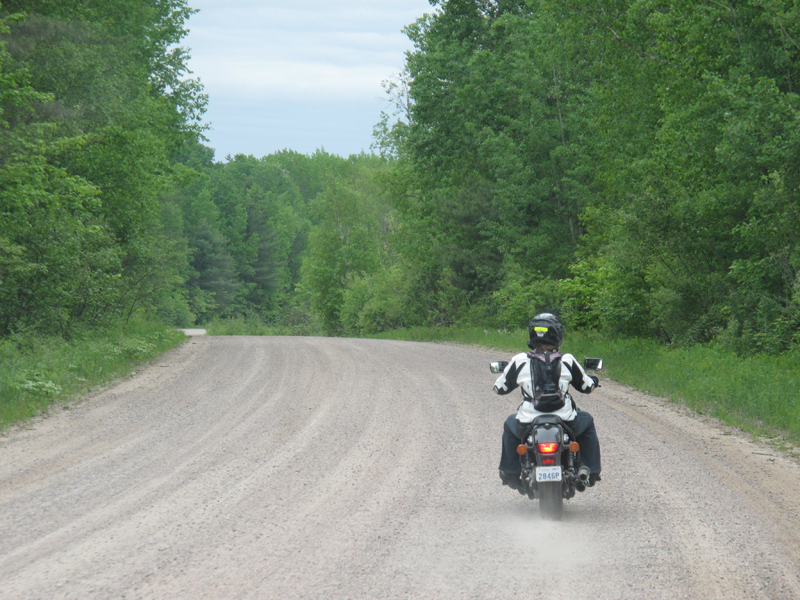
Minimize the motorcycle’s lean and abstain from any sudden input
Whether it’s gravel, dirt, sand, grass, or any slick surface, the same rules apply. You want to minimize the motorcycle’s lean and abstain from any sudden input such as braking, accelerating, or swerving.
I’ll say it again: Minimize the motorcycle’s lean and abstain from any sudden input such as braking, accelerating, or swerving.
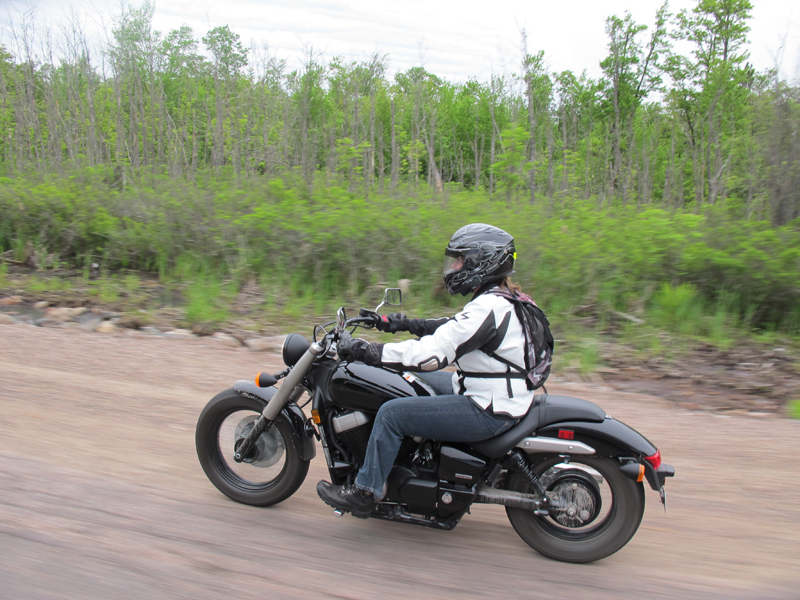
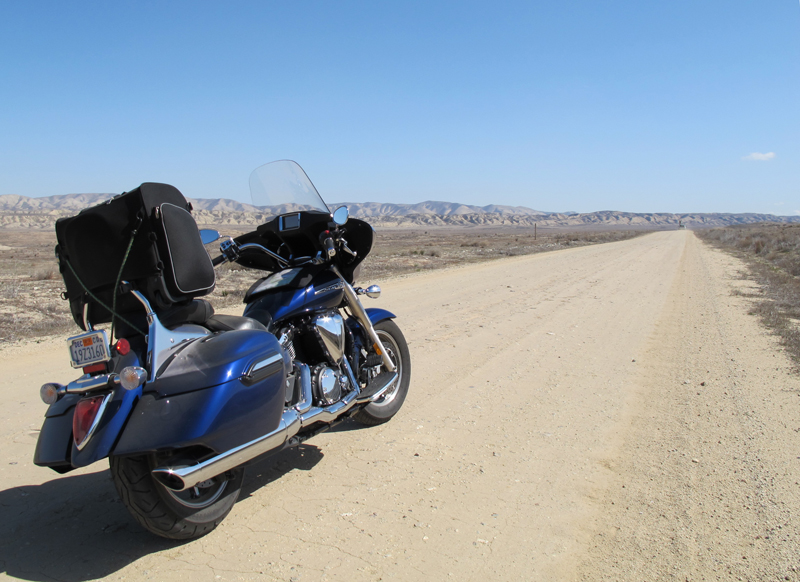
When we lose traction, defined as the “grip of a tire on a road,” it’s easy to lose control of the motorcycle. But don’t lose your head.
If your motorcycle is already in motion and you come up to a patch of gravel in the road, don’t panic. It’s best to maintain the momentum the motorcycle already has and slow down gradually, with very light use of both brakes. Your tires will slide easily, even on a light gravel surface, so if you brake too hard too fast you’ll likely produce a skid, lose control of the motorcycle and you may go down.
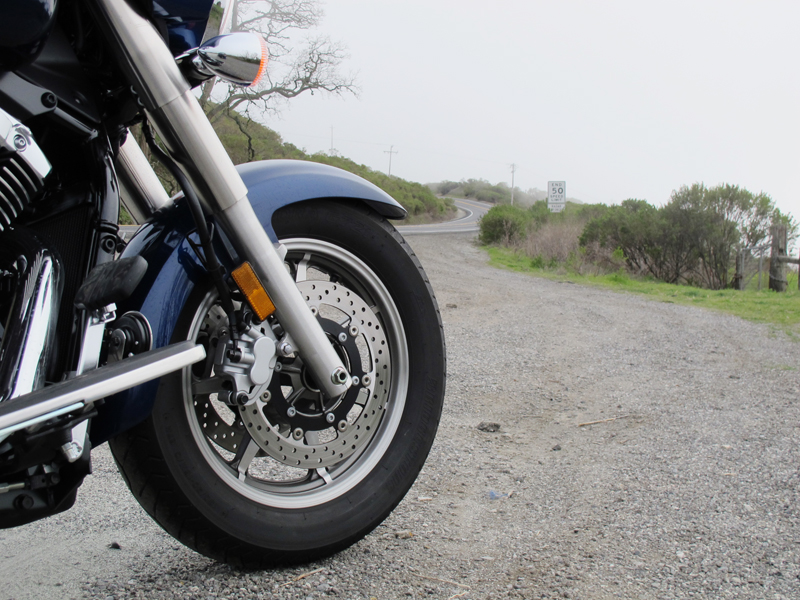
When the road ahead promises miles of gravel, you can turn around and find another route, or you can use these techniques to get through it.
Physically
- Keep your arms and shoulders relaxed, and steer the bike without fighting against it.
- Use a gradual throttle roll-on to accelerate and maintain a steady speed, which will most likely be a reduced speed. Try not to stop, but if you have to, start out again by using very light, gradual acceleration, so your tires dont spin out.
- Keep the motorcycle as straight up as possible, that is minimize lean, which may mean taking wide turns and using most of the road.
- Keep as much distance between you and other vehicles as possible to allow yourself a lot of extra room to gradually slow down to a stop.
- Remember the rule that you go where you’re looking, so avoid looking down. Stay focused on where you want to ride to, but continually scanning near and far, checking the road surface conditions so you’re aware of any big rocks or potholes to avoid. Looking far ahead will keep you heading in the right direction.
- Remember to breathe slowly with controlled breaths to keep your body calm so you don’t tense up. WRN founder Genevieve Schmitt advises using a Pilates breath. “I’m a Pilates instructor so I’m always using my Pilates breath to get me through tense situations calmly—like riding in gravel. Pilates breath is done by breathing in through the nose, and out through the mouth. This kind of breathing is best for controlling your breathing pattern so your body stays calm. The calmer you are, the more your mind will remember what to do so your body can respond appropriately to move you through the gravel successfully.
Mentally
- Tell yourself you will get through this.
- Listen to your inner voice. If you’re feeling confident then go for it. If the voice in your head says to turn around and you can, then listen to it.
- Don’t allow any negative thoughts to invade your brain like how bad it is to ride through gravel or that you will fall. If you employ the above techniques, you’re likely to power right through and be celebrating that you did so before you know it.
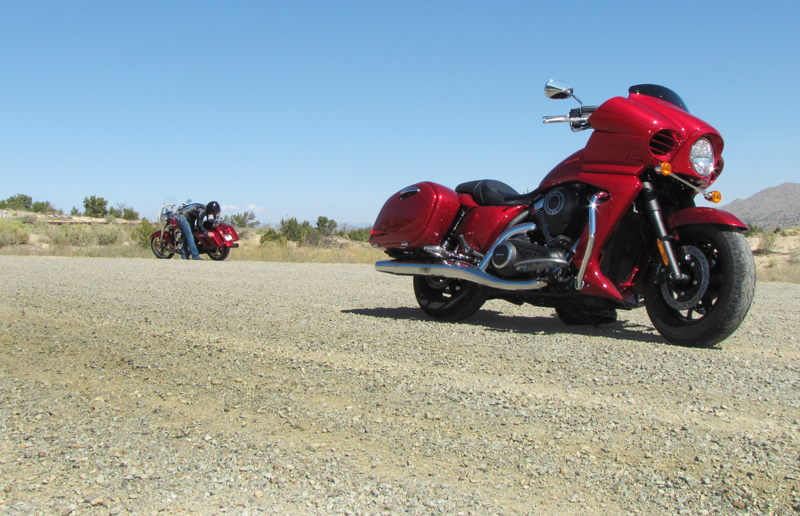
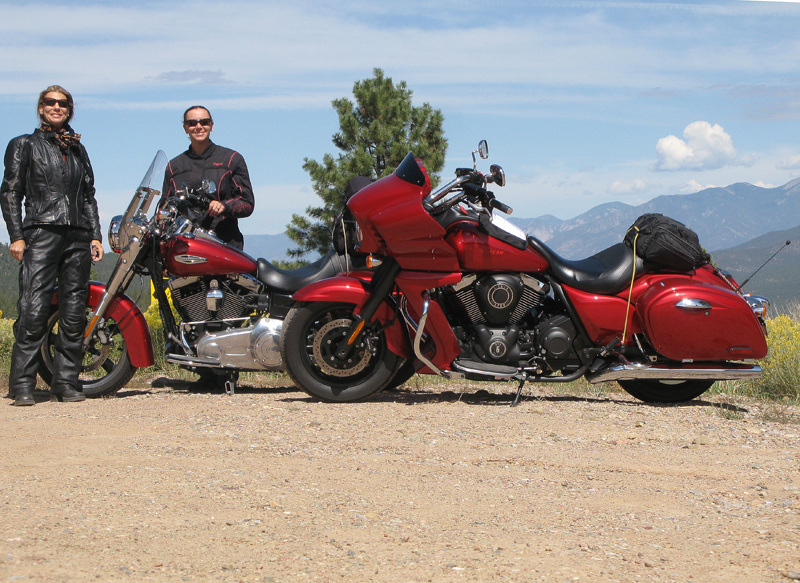
Seasoned street motorcycle riders know riding in gravel is inevitable. If you ride any long distances at all, you’ll likely hit upon road construction where fresh gravel has been laid for future pavement. It’s not a matter of avoidance, but a matter of learning to ride through it.

Love your advice. My gravel driveway is slanted from right (highside) to left (low side.) It’s like having one leg shorter than the other leg. Problem is, my bike is in my car shed and to get it out the safest way it’s all gravel. I have to back it out of the shed starting out straight then start turning front wheel and go backwards down the hill then when I’m out enough, I throttle up the hill while making a sharp turn to right then straighten up. It is such a stressful procedure. Any advice on backing up while going backwards downhill in gravel? Thanks.
Slow and steady. Keep bike in first gear, while pulling in the clutch. Let your front brake ease you down so you can keep both feet on the ground. Then when you’re ready to go forward, ease out the clutch while rolling on the throttle. The key is slow and steady though so as not to make any sudden moves. Move your feet slowly to ensure you have solid footing every few inches as you go backward. Keep both feet on the ground. Since you’re having success, sounds like you’re already doing this. Keep it going!
You forgot the part where you get off and kiss the pavement once you make it (safely) to stable ground!
You’re right, we did forget that part!
I’ve gotten used to gravel and dirt. And I have found that despite what most people are saying, you can use your front brake. You just can’t use it like you normally do. If I don’t use my front brake on my steep dirt and gravel driveway, I would end up having to use too much rear brake. That causes the rear wheel to skid a bit on the rocks. Not a good thing. And if you have ABS, you may end up on the ground.
Thank you for pointing this out, Dee. It’s important that everyone understands that the front brake is needed on gravel and dirt as it is on pavement. Never ignore either of your brakes, just learn how to apply them properly.
A couple of years ago I hit a 9-mile stretch of construction. It was capped off by about 300 yards of deep pea gravel. I was riding my Gold Wing at the time, normally a very well-behaved street bike that absolutely hates gravel. I did exactly what you recommend—kept it loose, rode slowly, and didn’t make any sudden changes other than the frantic waving at the Harley rider I could see coming up fast in my rear view mirror to slow down! We both got through it OK and immediately both pulled over for a breather after we got back on pavement. We shared one of those “I don’t care what you ride, that was ridiculous” moments that knows no brand boundaries. It was one of moments you hated while you were in it and love to talk about afterwards.Good article; I tagged my wife to read it, since she went down on a dirt road (where the pavement ended with no warning!) a couple of years ago.
Glad you made it through that experience in one piece, Ross! Thank you for sharing with your wife. We have lots of other great riding tips in our Riding Right section as well.
Good read.
I’m a new rider and have a new 2003 Honda Shadow Spirit. I have to travel on our gravel road on a daily basis. We live in the country and from the main road we’re down a 1/2-mile gravel road. I’ve learned to turn in and out of our road very carefully and as everyone has mentioned I try to stay relaxed and focus ahead, not down. I usually go about 10-15 mph and have some areas where the gravel is very thick and I have to cross over to the other side at both ends.I always have a fear of slipping and dropping my bike but while riding I chant to myself that I can do this, stay relaxed, keep the throttle steady and look ahead. Also, while I can place both feet flat on the ground when doing so on the gravel I’ve slipped a few times which has made me nervous but I try to stay strong and focus on gaining my confidence
Great article, just remember also that GPS lies sometimes depending on what state you’re in. And the lower the population base for a given county, the lower the amount of money collected for road maintenance.
I love all your articles—great advice for new riders and advanced riders. It’s great information if you are even thinking about riding your own bike.I would like to read more about stopping and starting on hills and making u-turns in gravel including inclines and slopes.My gravel driveway is challenging. I enter on flat, straight gravel, then make a sharp, inclined turn to the right, then left into a parking spot. For exiting, I have to back out of the space downhill with the front wheel turned to the left. Then when I’m back far enough so that I don’t hit an electric pole, I have to make a sharp right, then straight to exit onto the road. Sorry for the long story. I struggle with this every time. Any tips making this struggle easier would help. I have laid the bike down two times and don’t want to again.
Hi Helen,You can read about starting and stopping on hills here in our riding skills section.As for your very challenging driveway, I’m curious to know if you’ve tried walking the bike backwards, out of the uphill spot. Sometimes in difficult scenarios it’s easier to walk next to the bike, using your body to help you steady and maneuver the bike. Keep a couple fingers on the front brake lever to keep it moving slowly as you’re backing it up. Make sure your footing is secure so that you don’t slip.If you prefer to move the bike while seated, keep both feet in the ground so that you can use them as outriggers to steady the bike while you use the friction zone to get the bike up and around the hilly curves.Honestly, if I had a driveway like yours, as a motorcycle rider I would seriously consider paving it as soon as I could afford to.
If it wasn’t for a good friend living on a dirt road I might have detoured riding down eight miles of an unpaved road in the Colorado mountains, but am so happy I didn’t shy away because it was beautiful and so worth it.
I’d like to add to the part about physically making minor inputs and staying loose. By staying loose you allow the bike to wiggle around under you. It’s a bit disconcerting at first, but if you relax it’ll be fine. On a recent trip to Canada we hit two construction areas (each 10 to 20 miles long.) These are the same tips my hubby gave me and I succeeded! You can too. Now when I ride into gravel on the side of the road or driveways I don’t panic. Thanks for all the great advice!
I live on a gravel road so the only way I can get out is on one to two miles of gravel so I’ve learned a lot about it. The one thing I didn’t see in the article that I would like to mention is try not to use your front brake, if the road is a little bit soft or loose it will take you down in an instant. Just an FYI.
Thanks for the additional advice, Sharon!
Doesn’t sound like fun riding? Most of this advice is great, but it is for the very new and frightened rider. If you take gravel slowly and surely and in a straight line, you will be fine. If you are Pilates breathing chances are you are not enjoying this. Just go slow enough so that if you fall then you fall. Most gravel roads I know are deserted but then I live in Australia. It took me ages to get used to gravel but it’s actually pretty exciting now. A test of my abilities. Always if you ride within your capabilities and speed you should be OK, but it’s gotta be fun, otherwise why are you out there?
Anne Marie,Thanks for your thoughts, but honestly, after 26 years of riding, some of it is not exciting and fun. I’d rather not deal with deep gravel and sand on my street bike; nor would I like to deal with rain, cold, and wind. None of that is fun no matter how skilled of a rider I am. So, my advice in this article is not just for new riders, but for experienced riders too, like me, who have to be extra sharp when riding through more challenging conditions. And falling is not an option. Going too slow is not correct. You must go fast enough to keep the bike in motion to ride through the gravel safely. Too slow means you might fall. And that is not an option for me. I don’t want to end up with my big Harley-Davidson Street Glide on its side in a pile of gravel for many reasons, all of which I hope are obvious.
I grew up on a dirt road and now live on a gravel road. I learned to ride a street bike on that dirt road and never thought twice about it. You do what you have to do. I ride the gravel road, almost daily, and again, don’t think twice about it. After reading this article, I realized that I do most of those things. It’s a great article, especially for those who don’t encounter gravel roads on a regular basis. Keep up the good work and keep posting more useful articles!
This will be my fifth summer riding a motorcycle. Although gravel isn’t my favorite it doesn’t make me turn around and not proceed down it. My daughter, hubby, and grandkids live on a gravel road so lots of trips are made out there on the cycle. One tip my Hubby gave me that was very helpful was to shift my weight forward a bit to put a little more weight on the front. It provides more stability and traction. The article was great — slow and steady is the key.
The right tires are very important as well.
I agree totally with this article. I have riden on quite a few dirt roads and have been taught to put more pressure onto my foot pegs and lift off the seat if the gravel is very deep and let the bike wiggle if needed. Being in South Island of New Zealand we have quiet a few dirt roads to get to the nicest spots. Never be afraid of loose dirt.
I have been riding for 48 years and still avoid gravel whenever possible. I enjoyed any surface when I was a kid riding dirt bikes. These 800- to 1000-pound bikes are a different story. Get a little off balance and down you go. Just like the tortuous and the hare. Slow and steady wins the race.
I live out on a gravel road and have to travel on it. I’d say to seek out gravel roads and practice.
After several years of riding, I find this info very useful.
I live on a gravel road and I ride 2-1/2 miles to get to the blacktop road to go riding. I have a lot of experience in these conditions, and would recommend not using the front brake at all.
I have always been fearful of gravel, but if forced I’ve survived until last summer, 2015. A short gravel road with fresh gravel dumped in huge potholes was not a easy one. I made it once to my destination that day once but coming back from a poker run, I turned off pavement and hit one huge hole on my turn and went down. I messed up my elbow enough for needing stitches and learned a valuable lesson to wear my leather jacket no matter how hot it is out and be more watchful and careful. Thanks for this article!
All good comments, especially about heavier bikes. One last observation I’d make is, make sure you’re wearing good riding boots and be prepared for your feet to slip even on successful stops. Keep the bike as steady and straight as possible, and try getting both down cleanly when you come to a complete stop. This will minimize the chance of one foot sliding, and maximize the chance of catching it if one starts to slip. It’s helped me many times in my 40-plus years of riding, and most recently on my FLTRXSE (900-plus pounds)
I differ on one thing in this article. On dirt or slippery surfaces unless you have had a lot of experience in these conditions I would recommend not using the front brake at all.
Great article! Wish it had been out before I rode to Sturgis this summer. But I learned to ride on gravel in the Black Hills, and after reading the article, I did everything right!
Very good.
Great article. My only quibble is that I’d put the “don’t look down” tip at the top. Experienced riders will know this but less experienced riders may get uneasy in the saddle, and look down reflexively. I know; I did that once with predictably bad results.
Riding on gravel (dirt) is a technique that is not dependent on whether you are on a street bike, a dirt bike or a dual sport bike. The surface dictates the skills used to negotiate the terrain and traction available. In a dirt bike school, you will learn the proper techniques to to ride on dirt (which is what gravel roads are). You will learn on a smaller bike that you can then transfer to your street bike. It is a cheap, one day investment to expand your motorcycle skill set and enjoyment.Sherry (Dirt Bike Coach in Minnesota)Look for a local Dirt Bike School. https://training.msf-usa.org/RES/dbs/enroll/dbsintro
Great article. Thanks so much for this! Been riding a little over eight years and gravel always spooks me. We have family in Taos, New Mexico, and ride there every summer. New Mexico is the Land of Enchantment but also the land of hundreds of dirt roads. LOL! To get to my mother-in-law’s house you have to ride down two long loose gravel roads. Went down once on this road a couple years ago because I made the mistake of using the front brake while turning. Now I find that as long as I go slow and straight and only use the rear brake if I have to, I’m OK.
With a heavy bike stay off the front brake as it tends to make the front wheel of a motorcycle dig in and swerve, or low side. I agree with this one — you are absolutely going to find dirt roads. Just did from Placitas, north of Albuquerque, the back way to the Sandia’s mountain tram. It was a while before I got to the black top; very bad road for an 830-pound street cruiser, but the forest was great. Ten mph to the black top and no drops. Using the front brake caused the bike to dive and fishtail for me. Less speed is the ticket. Great article — you guys hit on everything. Placitas offers a good forest. The view from the top was really great.
Any directions in Arkansas start with ”turn off the paved road” so you learn pretty quickly how to do dirt. These were great instructions, and Barry N from PA added some good ones too.
Great article. Another tip is to hold the handlebar loosely, no “death grip.” The front wheel will wander some on gravel. Don’t try to fight it, hold on loosely and go with the flow. The bike will go straight, even though it may feel like it won’t. You will eventually get used to this loose feel.Like all other motorcycling skills, practice makes perfect. Look for gravel roads, and practice, practice, and then practice some more. If you are willing to ride on gravel, it opens up a whole new world of places and scenery missed by most riders.
I too, like Barb, live on a gravel road — all sizes, shapes, conditions depending on the maintenance or not! I found this article and comments helpful reminders. Like all our cycling situations, you think you’ve mastered it, and a challenge always presents. But being informed, relaxed, and able to make the right choices, makes the difference in the outcome! My biggest angst with gravel is not so much my road, but the intersections and just the odd spot in any road around here! Hence, always needing to be alert of the road conditions. I’ve lost my back end/tire skid many times, but have been able to keep the bike in control. Just a “whoa!” and I’m back on my way! Safe travels all.
I have had to ride gravel since I began riding. It is just part of where I live. I am actually glad for that, since most gravel doesn’t give me much issue anymore, but there are times, even with 40,000 miles under my belt, that mistakes are made. I had to take my bike down to storage because we have fire all around us right now, and we didn’t want to have to worry about the bikes.On the way down the mountain, somehow, a wasp managed to fly down past the collar of my shirt and jacket and into my clothing. I will say that having a wasp crawling around the bare skin of your stomach is not a fun feeling, but it hadn’t gotten me upset yet, so I was looking for a safe place to pull off on our mountain road.Then the wasp crawled back up towards my shoulder, finally got mad and started hitting me with its sting. At that point, the very next gravel pullout was it, and I managed to get onto it, but by that time I myself was getting pretty frantic, so I hit the front brake a little too hard and the bike went over as I bailed doing the “strip-off-all-gear-and-your-shirt-in-nano-seconds” dance to get that bloody thing out of my shirt.Thankfully I have a good sturdy set of crash bars on my bike, which, since I was already almost stopped, kept the bike from laying over completely, and also from sustaining any damage.I re-dressed and we picked up the bike, and continued on into town but yeah, gravel can be a pain in the butt at times.My advice is to practice riding in it, practice often like anything else, and this way suddenly finding out that the road to your campground is three miles of sand and gravel up a hill, or the driveway of your friend you going to visit is a steep curved deep gravel driveway, won’t phase you at all.
Intéressant.
This is very true. Everyone should learn to ride on gravel. Once you are riding outside of your learning area and start touring you will for sure have to deal with gravel roads, construction zones, and also gravel parking lots. I would also like to add be very careful with your front brake and don’t brake hard with it. I was going into a gas station and it was a gravel parking lot but I was coming in going down a hill. I knew I was coming in too fast so I used both brakes but more front brake, well the weight of taking a nose dive on the front end made my Suzuki Gladius’ front tire slide sideways. I kept her up and used my dirt biking skills but it sure scared the crap out of me! I am very careful now with my front brake especially on thick loose gravel. Hard packed is definitely easier and can actually be a lot of fun!
This was a great article! I wish I’d had it to learn from when I got my bike several years ago. We live on a gravel road, therefore I had to learn to ride on it from the very first. It was a wibbly-wobbly learning curve. The gravel they use here is big chunky granite. I have learned that the best speed for this type of gravel for my bike (Honda Shadow Spirit 750 – about 600 pounds) is around 20 mph. Too fast or too slow poses problems when the county has newly resurfaced our road. While staying relaxed is paramount, I discovered that holding my elbows closer to my body than usual helps provide better control of the handle bars when I inevitably hit a big chunk of gravel and the handle bars randomly jerk. (Yep, I learned this the hard way.) Main point? Different types of bikes (due to their weight and tires) are going to handle differently on differing types of gravel or sand. When turning around on gravel, boots with excellent traction are important. Also, if you live in the mountains or in a very hilly area, contemplate how gravity will affect your ride on gravel, especially if you have to turn around. Feathering your clutch is immeasurably helpful on gravel.
Great suggestions. A few more: don’t use the front brake in very loose gravel/sand. When it’s loose gravel using a “higher gear” at low speed is much easier to control wheel spin/traction. Also street cruisers are hardest to ride in gravel/sand, but just relax your body and “feel” the seat movements as it helps just to wobble with the seat. Same with a dirt bike — use the legs as “extra” springs as much as possible if your bike is not a cruiser. That means get your butt off the seat a little. You can see better, control the bike better and feel more confident is these conditions. Just another area needing practice.
Good article.
I wish I had this in my head before I laid mine down in a gravel drive. I was creeping into drive but had my hand on front brake and foot on back brake. I guess I turned to sharp to go into yard and when the bike slid I locked up front brake from fear of just holding on. Being a first time rider with a top heavy bike, we went down pinning my left leg between handlebars and tank. Split muscle in leg hurt knee, nice print of knee in tank. I have a FXLR 1993. People tell me I should of never started out on such a top heavy bike. But got it now, so push on. Thanks for the info. Will definitely share.
One thing I learned riding on deep gravel that I was surprised wasn’t included in the article was to use your rear brakes. By using the front it lowers the front forks and falling is inevitable.
Hi,I really enjoyed reading your article about how to ride on gravel safely. I’ve been riding my motorcycle (presently a Yamaha 1300Touring) for 20-plus years and still get spooked by gravel. I appreciate all the good safety tips in this article. Thanks
There are some great tips here. The same techniques can also be employed when riding on grated or grooved surfaces, something I encountered recently while riding long distance. What type of advice do you have to offer for making a U-turn on gravel surfaces, both from a stop and while rolling?
Same technique applies on a u-turn as any turn, whether stopped or rolling: smooth throttle control, make the turn as wide as you can, and most importantly, look through the turn — don’t look down. Depending on your level of confidence, you might need to “duck-walk” the bike through the gravel u-turn.